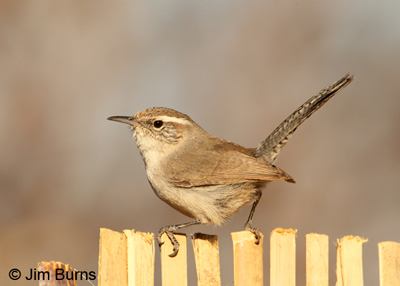
To non-birders, North America’s eleven wrens are all, with the possible exception of Arizona’s state bird, Cactus Wren, just look alike little brown jobs. To aspiring birders, however, the wren family is often their first serious identification challenge, and just as often it becomes the first challenge they conquer because, though small and rather nondescript, wrens are widespread, active, and announce with arresting songs & calls.
Audubon collected the first Bewick’s in Louisiana in 1821, and at that time it was a favored household neighbor throughout Appalachia and the Midwest. Today it has all but disappeared east of the Mississippi, due primarily to competition from the invasive House Sparrow, but it still thrives in much of the West, most abundantly in the dry, open habitats of central Texas and southern Arizona.
My first encounter with Bewick’s Wren, the first one I positively identified, occurred in November, 1975 in a typical wren scenario, the bird skulking about in the deep shadows of a dense woodpile on a dark and rainy day in the very inaptly named Fairweather Park near Seattle. Five years later, at sunup in Guadalupe Canyon on the Mexico border, my birding mentor, Pat Beall, helped me finally learn Bewick’s most typical song—“SEEEE-me-me-me-me-me.” Pat’s creative mnemonics always seemed to work for my unmusical ear, and now I’m usually able to identify Bewick’s song repertoire of sweet high notes interspersed with harsh trills before I find the bird with my eyes.
Over the years I have had several close encounters with denizens of the bird world (jimburnsphotos.com/pages/12-16-10.html), none more than with this little brown songster. Once, as I prepared to hike the footpath up Sonoita Creek in Lake Patagonia State Park, a Bewick’s flew into the open side door of my van and was trapped because all the windows and other doors were shut and I was standing there blocking the open doorway, slack-jawed trying to decide how to help it out. Its escape didn’t take long once I realized to open all the doors and windows and get the heck out of the way. Three months later a juvenile Bewick’s landed on the bill of my camo hat as I stood in a mesquite bosque near Kino Springs glassing a Gray Hawk nest in a huge old cottonwood.
My favorite Bewick’s encounter, though, involved an “I told you so” incident in Marion Paton’s Patagonia, Arizona backyard back in the day before Marion passed away. Robin Baxter had helped her install the canvas canopies in the newly designated hummingbird viewing area, but I asked if I could sit inauspiciously at the far end of the yard and photograph the songbirds coming to her seed feeders. She flatly refused citing her concern that my close presence would preclude anything coming to feed. I was in full camo and convinced her I would get low, be inconspicuous, and wouldn’t move. She finally agreed as long as no other birders came into the yard.
I situated myself at minimum focusing distance with my telephoto lens, got down on my knee pads, and froze. I was an old hand at this and correctly guessed what would happen. Within five minutes the birds began to come back, oblivious to my presence. Suddenly I felt something, unseen from behind me, land on my boot heel and begin walking up my calf. At my knee it jumped off and hopped into my peripheral vision, inches away. A Bewick’s Wren! I saw Marion in her kitchen window peering toward me with binoculars. I wanted to laugh and give her a thumbs up but didn’t dare flush her birds and lose my privilege.